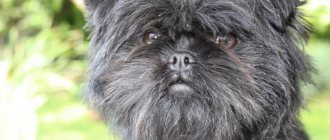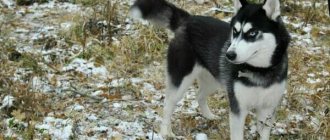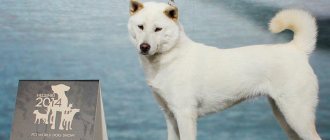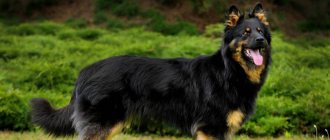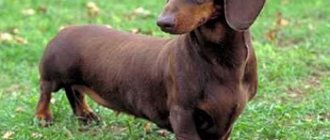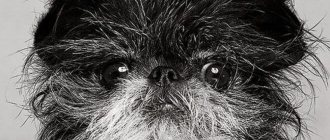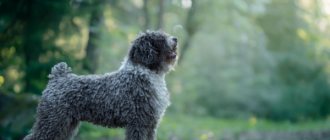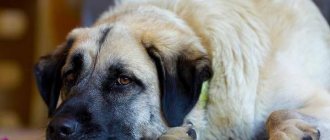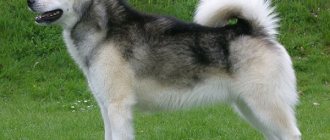- Pets
- >>
- Dog breeds
* Here is a photo of a typical representative of the Pyrenean mountain dog breed . You can send us photos of your animals by email, and we will post them on the website. Don't forget to send your pet's name.
Video
* We invite you to watch a video about the Pyrenean Mountain Dog . In fact, in front of you is a playlist in which you can select and watch any of 20 videos about a given dog breed by simply clicking on the button in the upper right corner of the window. In addition, the material contains quite a lot of photos. By looking at them you can find out what a Pyrenees Mountain Dog looks like.
In this article:
|
Rate the material!
[Total votes: 0 Average: 0]
How to choose a puppy
It is better to buy a dog from a kennel. This way, you are less likely to buy an inexpensive breed passed off as a Pyrenean.
When purchasing, pay attention to the characteristic features of the breed and the cost. A puppy costs between $1,000 and $2,000.
The Pyrenean Shepherd is an example of a herding dog that performs well during search and rescue operations and is considered suitable for guard work. Tolerance and friendliness make them attractive to couples with children.
History of the origin of the Pyrenean mountain dogs
This breed of dog was bred to protect houses and livestock in mountainous areas, and in terms of its qualities, Pyrenean mountain dogs can compete with breeds such as the Central Asian Shepherd Dog or Tibetan Mastiff. Thick fur protects these dogs from the cold and bites of large predators, which they were excellent at dealing with. Due to their endurance, these dogs were also used as carrier animals.
How these dogs got into the Pyrenees Mountains is still unknown. Some experts believe that the Pyrenean mountain dog is one of the oldest breeds that arose in Europe back in 1800 BC, and maybe earlier. There is also an opinion that the dog originates from Asia, where the breed was formed.
Interesting fact: The Pyrenean Mountain Dog was highly valued not only by peasants, who used it to herd animals and protect property. These dogs were also appreciated by rich people, who placed such dogs to guard rich mansions. In 1675, this dog breed even received official recognition among the courtiers.
Only towards the end of the 19th century did Pyrenean dogs come to America, where they received the well-deserved attention of many breeders. From there, the story of the growing popularity of this breed began: in the 20th century, the first exhibitions began to be held. During the First and Second World Wars, Pyrenean dogs provided significant assistance to soldiers, dragging the wounded from the battlefield and transporting valuable ammunition and cargo.
In the 20th century, serious work was underway to restore the Pyrenean dog breed. Today, their numbers are stable, and they continue to be popular among breeders.
Origin
All the most beautiful and refined things come from France. The Savoy Shepherd is no exception. The French Alps became its homeland.
It all started in ancient times. Before the arrival of the Romans, nomadic tribes lived in the Alps, or rather, they moved throughout the mountains. The nomads were engaged in breeding sheep, they needed a dog as a shepherd and guard. At the same time, the pet should not be too whimsical. Quite the contrary. The less the dog needs, the better.
It was the nomads who brought the formidable dog to the Alps. Legend has it that the nomadic dog was descended from a dog and a wolf. He had a very specific appearance in those days. The climate of the Alps caused the dogs to change somewhat and develop thick hair. Nowadays, the Alpine Shepherd is a dog with a medium to short coat.
Thanks to nomadic tribes, some of whom settled in the Alps, the world received an intelligent and cute dog. It is not very widespread outside of France, but in vain. The smartest animal with excellent working qualities.
Pyrenean Mountain Dog - description of the breed
Pyrenean mountain dogs are similar in appearance to wolf-like dogs of ancient breeds. For centuries, people have selected the largest puppies with the lightest fur so that it would be visible among dense vegetation. Also, white dogs were different from wolves, so shepherds did not confuse dogs with predators in the dark, and could also shoot wolves during a fight with a dog.
Pyrenean dogs have a large body and high height - from 75 cm. The weight of such dogs can reach 55 kg, but the dog does not look bulky. These dogs are quite elegant and easy to walk.
According to the standard, dogs should have a round skull, not massive, with a pronounced occiput. The length of the skull should be equal to the muzzle. The muzzle is wedge-shaped, the transition to the forehead is smooth, without a clear bend. These dogs have almost no brow ridges and cheekbones, and their cheeks are almost unpronounced.
The eyes of the Pyrenees Mountain Dog are small, almond-shaped and wide set. The color of the iris can be all shades of brown, up to almost black. The eyelids cover the eyeball well, but are not clearly expressed due to the dark color. Thanks to this, the dog’s gaze is considered conscious and attentive.
Pyrenees dogs have small, triangular-shaped ears that are set quite low. The tips of the ears are not sharp, but rounded, reaching the corners of the eyes. The fur on the top and bottom of the muzzle forms a convergence that extends to the base of the ear.
These dogs have a scissor or straight bite. Strong white teeth slightly tilted inward. The lips tightly cover the teeth and are black in color, as is the nose. The elongated body of such dogs looks overly elongated, more in length than in height. Pyrenean dogs have a straight, strong back with a low tail and a pronounced croup. The paws are strong, the joints are visible.
Characteristics of the dog
Appearance
Representatives of this breed are medium-sized dogs , but they cannot be called small either. Their relationship with wild dogs gave them a muscular body and strong bones, a wide and developed chest. Alpine dogs usually weigh 30-40 kg, and the height at the withers is from 45 to 55 cm. Thanks to their strong grip and quick reaction, they can easily cope with a predator alone. Savoy Shepherds have very developed vigilance, especially at night.
Limbs
These dogs are distinguished by large limbs, the front and hind legs are at an average distance from each other. They have hard black pads on them.
Head
The head is massive, and the ears are hanging, triangular in shape, slightly rounded at the ends, and lack hard cartilage. The shape of the head is slightly elongated. The tail is of medium length, set high. Towards the end it narrows and wraps into a ring; the dogs keep it lowered.
Wool
As for the coat, it is not very long, but has a thick undercoat. The coat color is either black and tan or two-tone with tan. But the main distinguishing feature of the coat color is the white mask on the face.
Lifespan
Savoy Shepherds live on average 15-16 years.
Popular colors of Pyrenees mountain dogs
The coat of the Pyrenees Mountain Dog is unique in its structure. Below there is a thick undercoat, dense, but very soft, pleasant to the touch. It is not long, so it is completely covered with a top layer of wool. The guard hair is straight, sometimes curls a little, but not curly.
The top layer of hair is very long and hard. The thick fur on the back of the hind legs forms something similar to pants, and a headband resembling a lion's mane grows around the neck. The tail is also covered with long hair, which becomes shorter towards the end. The muzzle and ears are covered with a smooth short coat. The thick coat of the Pyrenees Mountain Dog is self-cleaning, making this breed easy to keep.
Colors of the Pyrenean Mountain Dog:
- The most popular color is snow white. It is he who is valued among breeders as the most noble. Dogs with snow-white fur have the greatest chance of winning at a show;
- Colors with fawn and light beige spots on the body are allowed. The spots must be very large and barely visible. They do not take up more than a third of the white space on the dog;
- Darker spots are not allowed by all cynological organizations, but they do occur. These are light gray, reddish and badger spots that are located on the head or tail.
Character and habits of Pyrenean mountain dogs
Pyrenean mountain dogs are distinguished by exclusively positive qualities: kindness, patience, sharp intelligence and devotion to their owners. These large dogs have not lost their guarding qualities and still show a penchant for herding work. Despite this, Pyrenean dogs are excellent companions.
These dogs, due to their patience, love children, allowing them to ride on their backs. Even adult dogs can support children in playing with them, but at the same time they will not allow the child to get into trouble by vigilantly monitoring his movements. Pyrenean dogs are even used for the psychological rehabilitation of children who have developmental disorders.
Dogs also get along well with other pets, including cats. A well-mannered and intelligent dog will never touch someone who does not interfere with him or his owners. They do not show unreasonable aggression, on the contrary, demonstrating a balanced character. But due to their protective qualities, these dogs are always wary of strangers.
Interesting fact: When a stranger comes to visit, these dogs show increased interest in him, trying to sniff him. This way the dog makes sure that the stranger is not a threat to the owners, and then may even allow himself to be petted. But throughout the stay of strangers in the house, the dog will keep an eye on them.
Pyrenean dogs are good watchdogs. They faithfully guard the territory of the home and family members. The barking of these dogs and their menacing appearance can scare away any intruders. Although these dogs are not stubborn, they can sometimes show excessive independence, making decisions without the knowledge of their owners. For example, if a dog senses danger, he may leave the house to eliminate it.
In general, dogs are independent in making decisions, do not tolerate aggression towards themselves, but are ready to endure a lot from their owners.
Let's summarize
Let's highlight the main points about the Alpine Shepherd:
- Aboriginal primitive dogs.
- Unpretentious in content.
- They are in fairly good health.
- They need active physical activity and training.
- Very smart, but stubborn and do not like to obey.
- Dogs are guard dogs, so it is better for them to live in a private house.
- They do not get along well with cats and other dogs.
That's the whole story about the Alpine Shepherd, from its origin to the purchase of a puppy.
Whether to get such a dog or not is up to the future owner to decide. Representatives of the breed are not easy to find, but the dogs are excellent. What else do you need from a Savoy Shepherd? He guards the house, doesn’t let strangers in, and treats family members like bars of gold. The only drawback is that she doesn’t like cats or guests and is quite stubborn.
Interesting facts about Pyrenees mountain dogs
The Pyrenean Mountain Dog breed dates back about four thousand years, and during this time the breed has acquired many interesting qualities. It is reliably known that dogs of this breed were companions of shepherds who lived on the border of France and Spain. There is even evidence from documents that these dogs lived next to ancient people.
Over its long history, the dog has distinguished itself by many facts:
- Pyrenean dogs can stay awake for a long time. Originally it was necessary for them to guard the herds at night, but now that guarding is no longer required, the dog still retains this quality;
- These dogs are considered the royal dogs of France. This is one of the few examples when a working peasant dog came into use by the nobles due to its irreplaceable qualities;
- Louis XIV declared these dogs royal because he loved this breed very much;
- Queen Victoria, who generally loved dogs, received a Pyrenean puppy as a gift;
- The Marquis de Lafayette brought Pyrenean Mountain Dogs from Europe to America back in 1824, and the breed has still been growing in popularity since then;
- During the Second World War, almost all representatives of the breed were destroyed. They were indispensable in transporting heavy ammunition along mountain paths among the Alps;
- The restoration of the breed began in the 20th century, and the largest part of it was farmers who preserved these dogs;
- Pyrenean dogs influenced the development of the Saint Bernard breed, which almost became extinct in an epidemic in 1870 in the Alps.
History of the breed
Originally Alpine, they are also called Savoy, shepherd dogs lived away from humans .
But later, some individuals were domesticated and loved by many people for their devotion to the owner. But they took root best of all among the shepherds. Dogs have enormous strength, this gives them the opportunity to command the herd; at one time in the Alps they were the only dogs that helped in shepherding.
But gradually there were fewer and fewer Savoy Shepherds, this was due to the fact that a large number of dogs of other breeds were brought.
Alpine Shepherds were on the verge of extinction, but in a village remote from the Alps, people discovered several puppies of this breed, and from that day on, not only breed lovers, but also scientists began to restore the species.
Today the breed is not considered widespread, these dogs rarely participate in exhibitions, and the breed is never recognized by canine organizations. There is now only an approximate unofficial standard created in 1960.
Pros and cons of Pyrenees mountain dogs
The Pyrenean Mountain Dog has a number of advantages over other breeds.
These include:
- Unquestioning devotion to the owner;
- Smart, good learning ability. Dogs of this breed love to serve people, so they are willing to train;
- Excellent security qualities. Pyrenean mountain dogs are natural guardians, and they will defend their territory to the end;
- These dogs are peaceful, so you don’t have to be afraid that they will show aggression towards people for no reason;
- Independence. Often they can be left to their own devices, and the dog will not feel discomfort from this. Also, in emergency situations, these dogs are able to make decisions independently.
But this breed of dog also has a number of disadvantages. In addition to the enormous size, due to which the dog will not fit in the apartment.
These include:
- The need for proper training. A dog can be uncontrollable and dangerous if not handled;
- Careful care of the coat so that it does not get tangled;
- If a dog of this breed becomes aggressive, it will be difficult to retrain it;
- These dogs have only one leader, whose commands they will follow. Other people in the family are simply members of the pack;
- These dogs also need good and regular physical exercise.
Price of a dog
The most difficult thing about this dog breed is acquiring it. It is not popular in Russia, the CIS countries and Europe, so the opportunity to find it in small towns disappears by itself. The best option is to look for ads online. They don’t appear at shows often, but you can try your luck and look for your dream there. The Alpine Shepherd is not recognized by official organizations, so do not count on a rich pedigree.
The price for such a dog can range from 200 to 400 dollars, it all depends on where and from whom you want to buy it.
Breeding Pyrenean Mountain Dogs
Breeding a Pyrenees Mountain Dog is a complex undertaking that requires strict rules. This is the only way to obtain viable offspring that comply with the standard. To breed this breed, you should first obtain advice from specialists who have already done this. Choose reputable breeders.
A male who is ready for mating must be in excellent physical shape. The dog must be exposed to physical activity, eat properly, and have high muscle mass. Males are selected for their size, as well as for their character traits: calmness, poise, and obedience are important.
The first mating of a bitch should not occur earlier than the age of two. She must go through at least three heats - only then the dog is ready to bear offspring and subsequent births. An immature dog’s body can lead to the death of puppies and the adult itself. Also, mating too early can affect the quality of the offspring. A bitch should not give birth more than once a year.
For breeding, choose an animal without hereditary diseases and with all the necessary vaccinations. All features of the breed must be expressed in both parents: elongated body, narrow head, low-set tail, etc. It is better to introduce the bitch and the dog to each other in advance so that they do not get nervous when they meet.
Caring for Pyrenean Mountain Dogs
Dogs of this breed do not require special care, but in order for their thick and long coat to look well-groomed and beautiful, they need to be looked after. Ideally, the dog should be brushed every day, but some breeders do this two or three times a month if the dog lives outside year-round and performs official duties.
Important fact: During the shedding period, the dog is brushed several times a day, otherwise there is a risk of getting hard tangles.
It is harmful to wash dogs too often - it dries out their skin and damages their coat. It is better to use special shampoos with a whitening effect, especially if the dog is a show specimen. With the help of such shampoos you can get rid of the yellowness that occurs with age around the eyes, on the paws and on the stomach. In fact, bathing is not difficult, since Pyrenean mountain dogs never refuse to swim.
The rest of the care is standard. It is necessary to brush your teeth, keep your eyes and ears clean, and trim your nails to prevent dirt from getting under them. Some breeders trim the hair under the tail to prevent it from getting dirty.
Care also includes the following classic procedures:
- Inspect the fur for ticks after a walk;
- Treatment for skin and internal parasites;
- Vaccination.
Maintenance and care
Since the breed comes from the Pyrenees Mountains, where weather conditions are very harsh, including sudden changes in temperature, shepherd dogs are perfectly adapted to living outdoors all year round; it is enough to install a warm, windproof booth.
Suitable for keeping in private homes or farms; it does not require any special care.
It is necessary to trim the claws on the dewclaws, preventing them from curling and growing into soft tissue.
Diet of Pyrenees Mountain Dogs
Large dogs need the most nutritious and balanced food possible. These dogs are not picky about food, but the diet must be selected in accordance with natural food. Of course, premium ready-made food for large breeds is suitable, but homemade food is preferable for this breed. It should contain about 30 percent fat and carbohydrates, and 70 percent protein.
The diet of the Pyrenees Mountain Dog includes the following essential components:
- Raw meat. You can also serve it boiled, but occasionally – it is poorly digested by these dogs. It is worth giving preference to lean foods such as chicken, turkey, duck, rabbit, veal and lean lamb;
- Sea oily fish. It is strictly forbidden to give river water;
- A boiled egg is given two to three times a week, which gives dogs an important dose of protein and calcium;
- Lots of greens and vegetables: lettuce, cabbage, carrots, cucumbers. This will provide your mountain dog with fiber;
- Apples, pears, bananas, processed into puree, can be given once a week. Dried fruits are allowed as a treat;
- Kefir and low-fat dairy products: cottage cheese, cheese;
- Honey. It allows you to stabilize the digestive processes in the dog’s body.
The diet of puppies is different from that of adult dogs. It is important to provide plenty of fat and fiber so that the puppies grow strong and strong. Therefore, puppies also add fish oil, bran and brewer’s yeast to their general diet.
Diseases and health problems
This dog breed is incredibly healthy because dogs have been isolated from other breeds for thousands of years. They only crossed with each other, which is why they do not have genetic diseases. Harsh living conditions and hard work have made the Pyrenean mountain dog a very hardy, strong and healthy breed. However, there are a number of diseases that these dogs can be susceptible to under certain circumstances.
Hip dysplasia is a problem that any large breed owner can face. Excess weight and excessive exercise can cause your dog's back legs to become sore. She will begin to be reluctant to walk, limp, and over time may even stop walking altogether. Fortunately, modern veterinary medicine predicts this disease and successfully treats it.
Also, due to its large size, frequent paw dislocations and rickets are possible. Ear diseases, in particular otitis media, can occur due to insufficient ventilation of the ears, which fit tightly to the head. Therefore, your dog’s ears must be cleaned.
Important fact: Problems with the visual organs are not a common occurrence, but they do occur. Most often it is caused either by genetics, according to which the dog’s parents were ill, or by improper care.
Proper feeding, regular examination by veterinarians and timely diagnosis of diseases will help to avoid all these problems.
